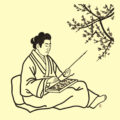Kireji (切れ字), or cutting words, are essential elements in traditional Japanese poetry, such as haiku and renga. They contribute to the structure, rhythm, and emotional depth of the verses, adding nuance and complexity to the poems. One of these kireji is “keru” (ける), which is often associated with retrospection. In this article, we will explore the “keru” kireji, its role in Japanese poetry, and its significance for those who do not speak Japanese.
The Role of “Keru” (ける) in Japanese Poetry
The “keru” kireji conveys a sense of realization or conclusion. It is often used to express a sudden insight or memory that emerges in the poet’s mind. When “keru” is used in a verse, it can create a sense of retrospection or reflection, allowing the reader to share the poet’s moment of revelation or recollection.
Examples of “Keru” (ける) in Haiku
To understand the use and impact of the “keru” kireji, let’s examine examples of its use in haiku, a traditional Japanese poetic form consisting of three lines and 17 syllables (5-7-5). Here are a few examples of haiku featuring the “keru” kireji:
A haiku by Matsuo Bashō (1644-1694):
春雨や 身を惜しむる かさの声
Harusame ya mi o oshimuru kasa no koe
Spring rain — keru, pitying oneself, the voice of the umbrella
In this haiku, the “keru” kireji emphasizes the poet’s realization of their self-pity as they listen to the sound of rain on the umbrella.
Another example by Bashō:
遠雷や 稲妻にけり 春の夜
Tōrai ya inazuma ni keru haru no yo
Distant thunder — keru, with the lightning, a spring night
Here, the “keru” kireji highlights the sudden realization of the connection between the distant thunder and the lightning on a spring night.
Understanding “Keru” (ける) for Non-Japanese Speakers
For non-Japanese speakers interested in traditional Japanese poetry, understanding the role of kireji like “keru” is essential. When reading a haiku or renga translated into another language, the “keru” kireji may not be explicitly present, but its effect should still be apparent in the translation. The translator should convey the sense of retrospection, realization, or conclusion that “keru” imparts to the verse. As a non-Japanese reader, recognizing the presence of kireji like “keru” and their impact on the poem will deepen your appreciation and understanding of the nuances in traditional Japanese poetry.
The “keru” kireji plays a significant role in traditional Japanese poetry, adding layers of retrospection and emotional depth to the verses. As the kireji of retrospection, “keru” helps create a more reflective and insightful experience for the reader. Understanding the significance and impact of kireji like “keru” is essential for those looking to appreciate the beauty and intricacies of traditional Japanese poetry, regardless of their language background.
- Glossary of Japanese Poetry Terms - 26 February 2025
- What is Waka Poetry? - 23 May 2024
- How to Identify the Kigo in a Haiku: - 22 March 2024





